Prevention of Violence Against Women and Girls - JERA International
Prevention of Violence Against Women and Girls - JERA International
Prevention of Violence Against Women and Girls - JERA International
Create successful ePaper yourself
Turn your PDF publications into a flip-book with our unique Google optimized e-Paper software.
E/CN.6/2013/4<br />
increase women’s access to labour markets <strong>and</strong> financial resources, with a focus on<br />
rural <strong>and</strong> immigrant women. Despite progress, 13 discriminatory laws <strong>and</strong> practices<br />
continue to exist, also in relation to women’s rights to marriage <strong>and</strong> divorce,<br />
inheritance <strong>and</strong> decent work. 14<br />
26. Addressing women’s economic inequality is <strong>of</strong> particular importance.<br />
Evidence is emerging <strong>of</strong> the effectiveness <strong>of</strong> micr<strong>of</strong>inance programmes in reducing<br />
violence against women <strong>and</strong> girls in the long term. Such programmes are<br />
particularly effective when they promote gender equality <strong>and</strong> engage men, boys <strong>and</strong><br />
the broader communities. In South Africa, for example, the evaluated Intervention<br />
with Micr<strong>of</strong>inance for AIDS <strong>and</strong> Gender Equity study demonstrated a 55 per cent<br />
reduction in intimate partner violence over a two-year period. 14 Nevertheless, such<br />
programmes should consider, prior to implementation, the adverse effects that may<br />
occur in the short term, including an increased risk <strong>of</strong> violence against women <strong>and</strong><br />
girls, as traditional gender roles are challenged.<br />
27. <strong>Women</strong>’s empowerment <strong>and</strong> participation in conflict resolution, peacebuilding<br />
<strong>and</strong> overall decision-making in post-conflict contexts is crucial in preventing<br />
violence against women <strong>and</strong> girls. <strong>Women</strong>’s meaningful participation in peace talks,<br />
peacekeeping missions, the security sector, transitional justice processes,<br />
peacebuilding institutions <strong>and</strong> decision-making bodies is crucial in creating a safer<br />
post-conflict environment.<br />
28. National action plans <strong>and</strong> interventions that specifically address violence<br />
against women <strong>and</strong> girls are a critical component <strong>of</strong> a prevention strategy <strong>and</strong><br />
provide the framework for the development <strong>and</strong> implementation <strong>of</strong> comprehensive<br />
<strong>and</strong> coordinated strategies. A review <strong>of</strong> such national action plans <strong>and</strong> policies<br />
indicated that most policies were limited to responding to violence, while those that<br />
contained specific prevention activities mainly focused on awareness-raising <strong>and</strong><br />
school-based programmes. 15 Many reporting States, including Denmark, Malta,<br />
Mauritius <strong>and</strong> Slovenia have adopted national action plans to address violence<br />
against women in general, or in specific forms, similarly including prevention<br />
measures, such as awareness-raising.<br />
29. In many conflict <strong>and</strong> post-conflict settings, Governments have adopted<br />
national action plans on gender-based violence or on women, peace <strong>and</strong> security<br />
more broadly, which include provisions to prevent violence against women <strong>and</strong><br />
girls. In such settings, all actors should ensure that prevention <strong>of</strong> violence against<br />
women <strong>and</strong> girls is also integrated into broader policies that cover contingency <strong>and</strong><br />
recovery phases.<br />
30. Lack <strong>of</strong> adequate resources <strong>and</strong> coordination were identified by human rights<br />
treaty bodies as challenges for the implementation <strong>of</strong> national action plans <strong>and</strong><br />
policies. In order to enhance such coordination, several States, such as Denmark,<br />
Estonia, Finl<strong>and</strong>, Mauritius, Mexico, Pol<strong>and</strong>, Spain, the Sudan, Switzerl<strong>and</strong> <strong>and</strong> the<br />
United Kingdom <strong>of</strong> Great Britain <strong>and</strong> Northern Irel<strong>and</strong>, reported on the<br />
__________________<br />
13 For a measurement <strong>of</strong> gender equality in different countries, see Social Institutions <strong>and</strong> Gender<br />
Index, Organization for Economic Cooperation <strong>and</strong> Development.<br />
14 World Bank, World Development Report 2012: Gender Equality <strong>and</strong> Development (Washington,<br />
D.C., 2011).<br />
15 UN-<strong>Women</strong>, “H<strong>and</strong>book for national action plans on violence against women” (2010); the plan<br />
<strong>of</strong> the government <strong>of</strong> Victoria (Australia) adopted a holistic approach to violence <strong>and</strong> its<br />
prevention; see similar conclusions contained in A/HRC/17/23.<br />
8<br />
12-65973


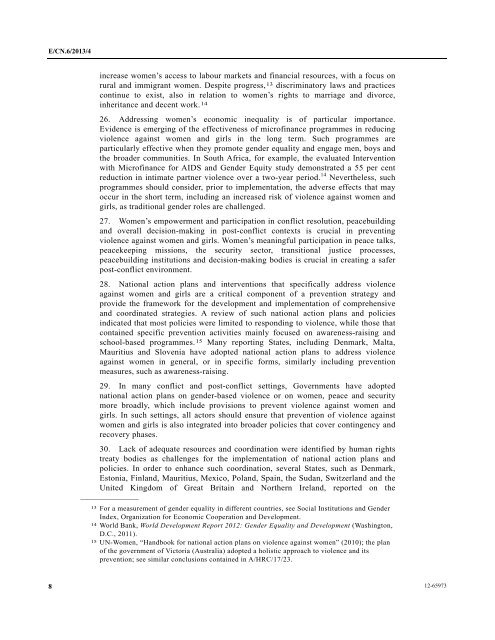
![IANSA [PDF, 2MB] - PeaceWomen](https://img.yumpu.com/25206379/1/190x123/iansa-pdf-2mb-peacewomen.jpg?quality=85)
![Commitments Sample [PDF, 93KB] - PeaceWomen](https://img.yumpu.com/25206331/1/190x245/commitments-sample-pdf-93kb-peacewomen.jpg?quality=85)


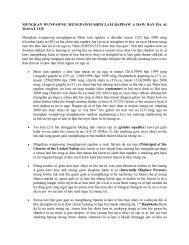
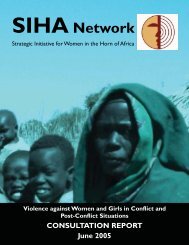




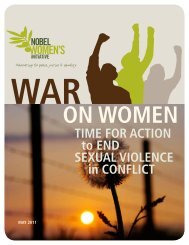
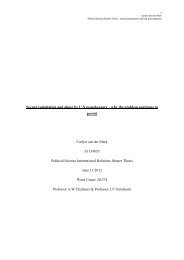

![A Toolkit for Advocacy and Action [PDF, 260KB] - Peace Women](https://img.yumpu.com/25205989/1/190x245/a-toolkit-for-advocacy-and-action-pdf-260kb-peace-women.jpg?quality=85)